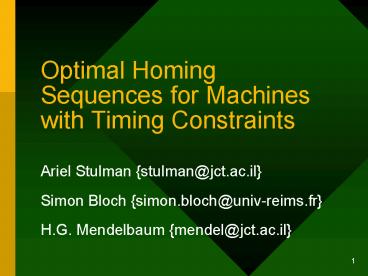Optimal Homing Sequences for Machines with Timing Constraints - PowerPoint PPT Presentation
1 / 16
Title:
Optimal Homing Sequences for Machines with Timing Constraints
Description:
A timed-IUT is a machine with timing constraints on its state transfer function. ... An optimal timed homing sequence is found using a breadth-first search algorithm ... – PowerPoint PPT presentation
Number of Views:72
Avg rating:3.0/5.0
Title: Optimal Homing Sequences for Machines with Timing Constraints
1
Optimal Homing Sequences for Machines with Timing
Constraints
- Ariel Stulman stulman_at_jct.ac.il
- Simon Bloch simon.bloch_at_univ-reims.fr
- H.G. Mendelbaum mendel_at_jct.ac.il
2
Introduction
- Homing sequences (HS) are input sequences that
induce specific output so as to allow a tester to
infer the final state of an IUT (Implementation
Under Test) regardless of its initial state. - An optimal homing sequence is a HS containing the
minimal number of input symbols that still allow
for a solution.
3
Introduction
- A timed-IUT is a machine with timing constraints
on its state transfer function. - A timed homing sequence is a HS that includes the
timing for the input literals. - An optimal timed homing sequence is minimal timed
homing sequence (fewest input literals).
4
Description of Problem
- Finding an optimal homing sequence is a well
known problem, fully solved. - (see Kohavis book Switching and Finite
Automata Theory) - We wish to find an optimal timed homing sequence,
taking into account the timing constraints of the
t-IUT.
5
Proposed Solution
- Define a current state uncertainty (CSU) as a
vector containing groups of states, grouped based
on similar output to some specific input
sub-sequence. - A homogeneous state uncertainty vector is a CSU
vector where each sub-group contains only one
element (one or more times).
6
Proposed Solution
- Let us build a tree that with every edge we
associate an input symbol and a timing
constraint, and with every node we associate a
current state uncertainty vector based on the
concatenation of the input and constraints on the
edges on the path to the specific node.
7
Proposed Solution
- An optimal timed homing sequence is found using a
breadth-first search algorithm looking for a node
that is associated with a homogenous state
uncertainty vector. - The optimal timed homing sequence is constructed
by concatenating the labeling (input and time
constraints) on the edges of the tree on the path
to the above node.
8
Example t-IUT
9
Example timed homing tree
10
Example timed homing tree
- Time regions were chosen based on possible
relevant changes to the t-IUT. - All terminal nodes were marked by a dashed line.
- The two non-relevant (NR) nodes were inserted for
the sake of completeness.
11
Example optimal timed HS
- Node 9 is the first node found during a breadth
first search that contains a homogenous
uncertainty vector (each sub-group contains only
one element one or more times). - The optimal timed HS is constructed by
concatenating the labels on the path to node 9
namely, 0c3 1cgt2.
12
Example optimal timed HS
- Normally, a table is constructed to determine the
final state based on the t-IUTs output sequence. - This is a special case where no table is needed
because the t-IUT will reach the same final state
(A) regardless of the initial state.
13
Example optimal timed HS
- Optimal timed homing sequence 0c3 1cgt2
14
Proof of optimality
- Nodes at higher levels of the tree, necessarily
represent shorter HSs than nodes at lower levels
(there are fewer edges in its path). - Any node that is not associated with a homogenous
CSU vector cannot represent a complete solution
for uniquely identifying the final state.
15
Proof of optimality
- By the definition of a breadth first search,
there cannot be a node at a higher level of the
tree that is also associated with a homogenous
CSU vector (otherwise it will be found by the
search first). - Hence, the path to the node found must represent
the shortest sequence that uniquely identifies
every final state.
16
Closing Remarks
- We proposed a method for generation of optimal
homing sequences for machines with timing
constraints. - Comparison to another possible method is
presented in the written article. - The relevance of our algorithm is mainly for the
field of testing real-time machines.































